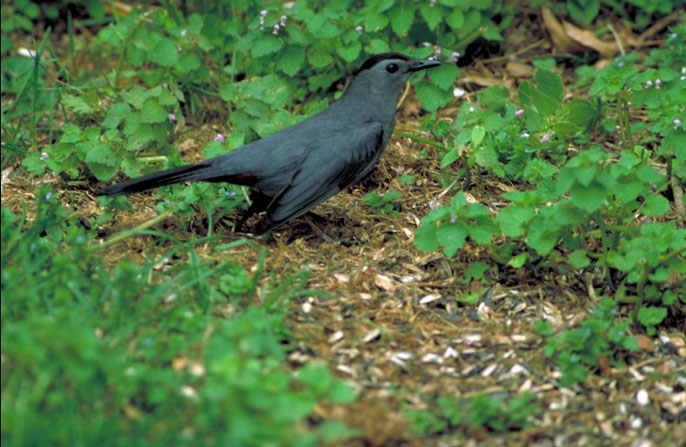In addition to the birds that regularly visit Yosemite, there are birds that get lost and end up visiting Yosemite by accident. We call these birds vagrants. On October 2, 2012, local naturalist Michael Ross spotted a bird he had never seen before, at least not in Yosemite. The bird was in brushy habitat near The Ahwahnee. After careful observation, he determined it was a gray catbird (Dumetella carolinensis).
The scientific name Dumetella translates as "small thicket" and carolinensis, as "Carolina," where it probably became known to science. The gray catbird lives in dense shrubby vegetation similar to the habitat where Ross found it in Yosemite Valley. The species is rare in the Sierra Nevada but people have seen it. This is only the second recorded sighting in Yosemite National Park, reflected by the total number of birds on our checklist at 264 species. The first sighting was in July 1993 near the Wawona Post Office in similarly dense shrubby habitat.
The gray catbird does not nest in California. The nearest locations it does nest are the northeastern half of Washington, the northeastern corner of Oregon, the northeastern corner of Nevada, Utah, Arizona, and all the way to the east coast. It winters in a narrow band around the Gulf of Mexico, including most islands in the Bahamas as well as parts of Central America. Usually gray catbirds in the western part of their range fly east and then south to the Gulf. In this case it probably flew directly south from Washington or Oregon and followed the Sierra.
In addition to mewing sort of like a cat, the gray catbird whistles, makes harsh chatters, squeaks, and can mimic other birds or sounds it hears in its neighborhood. This vocal virtuosity comes from the structure of its voice box, or more properly syrinx. The syrinx in birds consists of modifications of the two bronchial tubes, which rise from the lungs where they join together at the trachea (or wind tube). The gray catbird can work the left or right side independently, switch back and forth, or use them both simultaneously. Because of this ability, it can sing simultaneously in two voices!

US Fish & Wildlife Service Photo by Thomas Barnes
